- Quick Read
- Deep Read ( 5 Min. )

Why is Christian Science in our name?
Our name is about honesty. The Monitor is owned by The Christian Science Church, and we’ve always been transparent about that.
The Church publishes the Monitor because it sees good journalism as vital to progress in the world. Since 1908, we’ve aimed “to injure no man, but to bless all mankind,” as our founder, Mary Baker Eddy, put it.
Here, you’ll find award-winning journalism not driven by commercial influences – a news organization that takes seriously its mission to uplift the world by seeking solutions and finding reasons for credible hope.
Explore values journalism About usIn Today’s Issue
Monitor Daily Podcast
- Follow us:
- Apple Podcasts
- Spotify
- RSS Feed
- Download
TODAY’S INTRO
The story of Beit Jann is a light amid the darkness
 Mark Sappenfield
Mark Sappenfield
There is an unspoken truth in journalism: You find what you look for. There is undeniable anguish and inhumanity in Israel and Gaza. We have reported on it extensively. But there is also hope and light in the darkness. Just read Taylor Luck’s story today.
Many organizations don’t look for these things because they think they’re not there or not news – that they’re comparatively unimportant or even naive. We disagree in the most vehement terms. These things are the seeds of any viable future, the substance of any potential progress. That makes them not only news, but also absolutely essential news.
Share this article
Link copied.

Help fund Monitor journalism for $11/ month
Already a subscriber? Login

Monitor journalism changes lives because we open that too-small box that most people think they live in. We believe news can and should expand a sense of identity and possibility beyond narrow conventional expectations.
Our work isn't possible without your support.
Can Nikki Haley exploit Trump vulnerability in suburbs?
Suburban voters often play a pivotal role in U.S. elections. They were key to Joe Biden’s presidential win in 2020. Nikki Haley hopes they’ll propel her to a surprise win in New Hampshire’s Republican primary.

With Florida Gov. Ron DeSantis largely skipping New Hampshire to focus on later primaries, former South Carolina Gov. Nikki Haley now has a kernel of truth for her assertion that “it’s a two-person race” for the Republican presidential nomination – at least in the Granite State.
Polls show her running second here in New Hampshire, on average 13 percentage points behind former President Donald Trump. The battleground demographic is suburban voters – particularly those in the well-populated southeastern region.
“If she has a chance, it is in the suburban part of the state – especially in the more upper-class, more highly educated towns,” says Andy Smith, director of the University of New Hampshire Survey Center.
A Politico analysis of the Iowa caucuses earlier this week showed that Mr. Trump may be vulnerable among suburbanites. If he becomes the nominee and that pattern plays out nationally, the implications for the general election could be huge.
Ms. Haley’s pitch here is about electability. Her messages resonate with Darcy Tuoti, a retiree in the town of Hooksett. Ms. Tuoti says Ms. Haley “just seems like the person who can hopefully unite the country most.”
Can Nikki Haley exploit Trump vulnerability in suburbs?

Here in suburban Pembroke, New Hampshire, all eight flyers that arrived at the home of some registered Republicans this week focused on former South Carolina Gov. Nikki Haley: four in support, four against.
And with Florida Gov. Ron DeSantis largely skipping New Hampshire to focus on later primaries, Ms. Haley’s assertion that “it’s a two-person race” for the GOP presidential nomination now has a kernel of truth, at least here in the Granite State. Her third-place finish in Monday’s Iowa caucuses, just behind Governor DeSantis and well behind former President Donald Trump, was enough to keep going.
This has been the Haley game plan all along: Make it through Iowa, then go for broke in New Hampshire. Polls show her running second here, on average 13 percentage points behind Mr. Trump. The battleground demographic is suburban voters – particularly those in the southeastern region, two-thirds of the state’s population.
“If she has a chance, it is in the suburban part of the state – especially in the more upper-class, more highly educated towns,” says Andy Smith, director of the University of New Hampshire Survey Center.
Suburban voters proved pivotal in Joe Biden’s 2020 victory over Mr. Trump. And a Politico analysis of precinct-level results and entrance polls from the Iowa caucuses showed that Mr. Trump may be vulnerable among those same voters in the current cycle. If that plays out nationally, the implications for the general election could be huge if Mr. Trump is the GOP nominee.
Ms. Haley’s pitch here needs to emphasize electability, political analysts say. In a quick appearance Thursday at the iconic Robie’s Country Store in Hooksett, she did just that.
In general election polls, “Trump is tied with [President Joe] Biden, and on a good day, he might be up by two,” Ms. Haley says in a brief version of her stump speech, referring to a Wall Street Journal survey last month. “We beat Biden by 17 points!”
On average, a Haley-Biden general election polls currently as a dead heat, similar to Trump-Biden matchups.
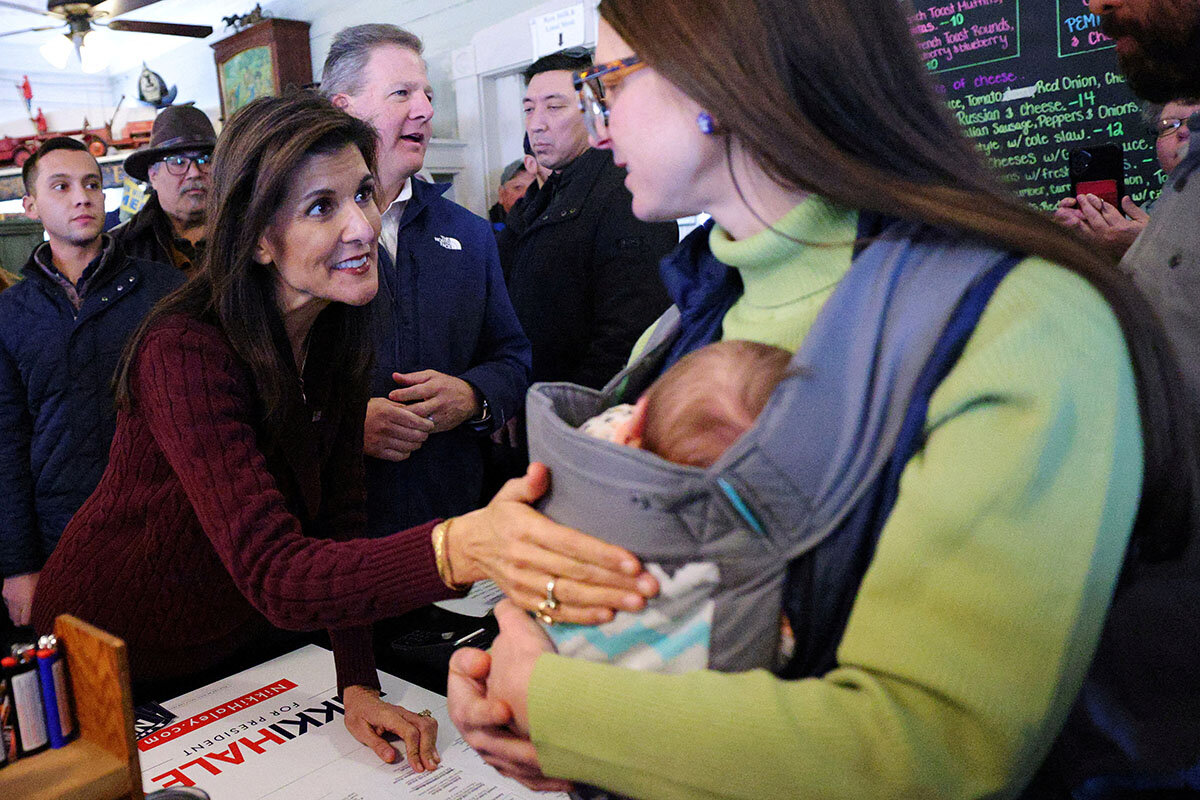
Haley’s appeal with suburban voters
Robie’s may not seem the epitome of suburbia. Nestled along railroad tracks and the Merrimack River in the southeastern New Hampshire town of Hooksett, this family-run small business oozes rural charm.
But Hooksett is within commuting distance of Boston – and in the Boston media market, which qualifies it as a suburb. Jan Dodge, a retiree who came in to get lunch and see Ms. Haley, worked for a private equity firm in Boston for more than 25 years while living in Hooksett.
What does she think of Ms. Haley?
“I like that she has a foreign policy knowledge and would support Ukraine, whereas Trump would just hand it over,” Ms. Dodge says, alluding to Ms. Haley’s two years as U.S. ambassador to the United Nations under Mr. Trump.
The space at Robie’s is small and packed – reporters and cameras may well outnumber voters – and many of the voters here are retired. Darcy Tuoti worked in public health, and her husband, Frank, was a machinist. They’re both registered Republicans and voted for Mr. Trump in the past. But Ms. Tuoti says she considers herself an independent – and will probably vote for Ms. Haley on Tuesday.
“She just seems like the person who can hopefully unite the country most,” Ms. Tuoti says.
On Friday, news broke that GOP Sen. Tim Scott of South Carolina, a former nomination rival, would endorse Mr. Trump. This has heightened speculation that Mr. Trump might put Senator Scott, who is Black, on the ticket. Given the ex-president’s running controversies around race – including false suggestions that Ms. Haley isn’t eligible to run because of her Indian heritage (she is U.S.-born) – having a Black running mate could help Mr. Trump’s image.
One battleground: “undeclared” voters
Earlier this week, Ms. Haley held a rally in the historic hotel at Bretton Woods, in the shadow of Mount Washington. This was well north of the state’s Boston commuter region, but there was still a suburban vibe to the crowd of about 150 people who had braved a snowstorm to attend: well-dressed and polite.
In fact, most U.S. households describe themselves as “suburban,” and so going for those votes can be a squishy proposition.
Being suburban “is a state of mind more than anything else,” says Chris Galdieri, a political scientist at St. Anselm College in Manchester, New Hampshire.
In interviews, attendees at the Bretton Woods event echoed those of the Robie’s crowd. Some Republicans and “undeclared” voters who previously supported Mr. Trump said they were ready for someone without the baggage. Some were disaffected Biden voters, like Michelle Overhoff, assistant principal at Groveton High School in northern New Hampshire.
Ms. Overhoff said she is unhappy with what she calls “lagging education reform” and the loss of COVID funding in an area she calls “socioeconomically challenged.”
“With Trump, the economy was good,” says Ms. Overhoff, a self-described independent. “But as an educator, I value integrity and acceptance of all. And civility.”
She said she’s leaning toward Ms. Haley in the primary – a vote she can make as an “undeclared” voter.
But not everyone at Bretton Woods was impressed by Ms. Haley – especially when she didn’t take questions from the audience.
“She didn’t rock my world,” says David Magnone, a ski resort contractor from nearby Whitefield.
Ms. Haley’s support for foreign wars didn’t persuade his companion, Melissa Boyd: “Our battles are not overseas,” she said. “They’re from within.”
Ultimately, Ms. Haley faces a steep climb in trying to overtake Mr. Trump on Tuesday, says Dr. Smith, the University of New Hampshire pollster. About 40% of New Hampshire Republicans are solidly for the former president, and Ms. Haley can’t just rely on suburban voters to do the job, he says.
“She has to not only get them to come out, she has to expand from that,” Dr. Smith says. “That’s the harder challenge for her. How do you get people who don’t really dislike Trump to vote for you?”

Today’s news briefs
• Huge NATO war games: The organization will launch its largest military exercises in decades next week, including about 90,000 personnel and aimed at showing Russia that the alliance is determined to defend all of its territory.
• Student debt canceled: The Biden administration approves debt cancellation for 74,000 student loan borrowers. The debt cancellation totals nearly $5 billion, the White House says.
• Northern Ireland strikes: Tens of thousands of public sector workers across the country walk off the job to protest a political deadlock that left them without pay increases, and the region without a functioning government.
• Japan moon landing: The Smart Lander for Investigating Moon (SLIM) lands on the moon, making Japan the fifth country to achieve a moon landing, joining the United States, the Soviet Union, India, and China.

Israeli Druze village has a message: Hope and peace
In Beit Jann, an Israeli Druze village with views of Lebanon, Syria, and Jordan, the outlook is one of determined optimism. Even as the entire region is gripped by uncertainty and rising violence, villagers speak of peaceful coexistence.
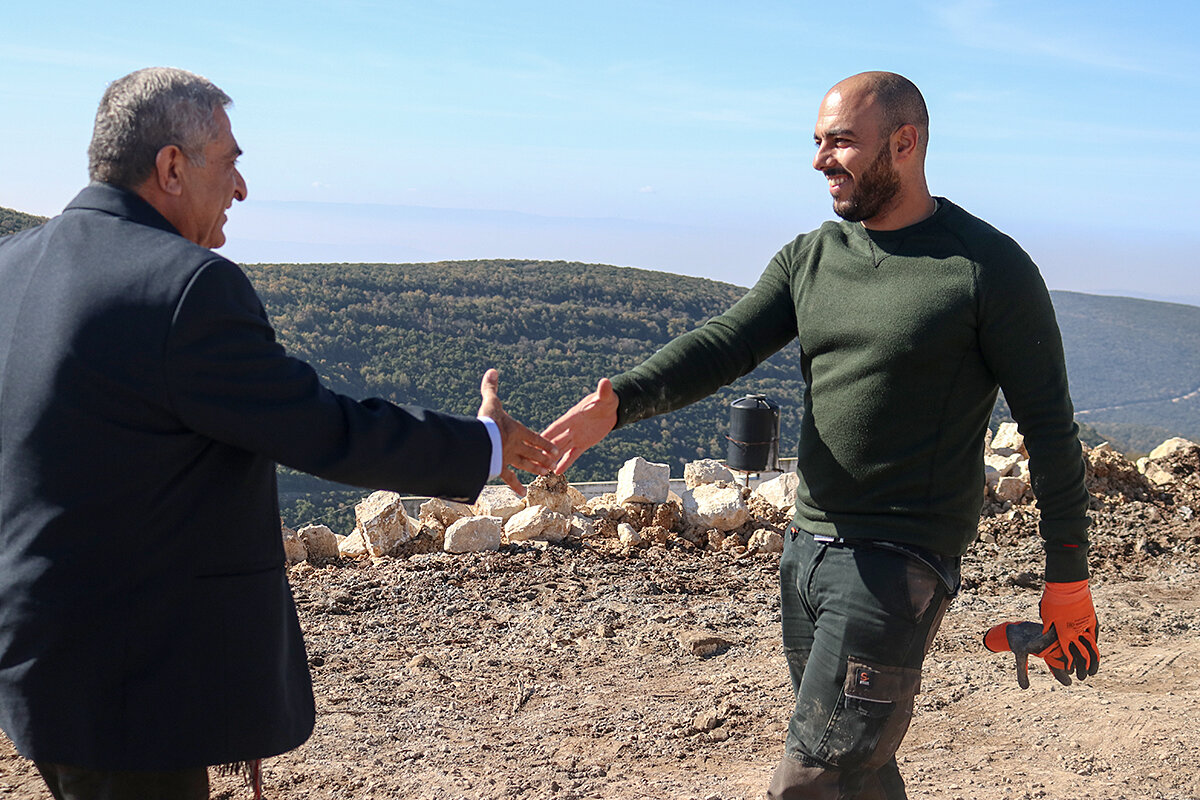
- Quick Read
- Deep Read ( 4 Min. )
Less than two weeks after a pair of rockets from Lebanon hit the outskirts of this mountain village, one of the last inhabited communities this far north in Israel, residents were busy building homes, renovating streets, and inviting friends and strangers to lunch.
The Druze villagers, members of an Arab religious minority that has lived in the area for centuries, say their coexistence with Jews, Muslims, and Christians could be a template for easing enmity among neighboring countries mere miles away.
Located in the heart of a nature reserve that had been witnessing a tourism revival, Beit Jann normally sees thousands of weekend visitors: bird-watchers, backpackers, and couples looking for a romantic getaway.
“We want everyone to come here, try our hospitality, and experience the peacefulness among these mountains,” resident Suzan says, taking her toddler to school on a day the village’s Peace Park was empty.
“There is concern and insecurity, but there is also something stronger: hope and peace,” says Beit Jann’s mayor, Radi Najm. “We want everyone to come here, share our message of peace ... and see coexistence among peoples is possible. We can disagree with one another, but we can still show empathy, understanding, and respect.”
Israeli Druze village has a message: Hope and peace
The first thing you notice in Beit Jann is the smiles.
Cheerful hellos, animated across-the-street waves, gentle needling and in-jokes – you would be hard-pressed to tell that these are people living on the front lines of an escalating war.
On Thursday, less than two weeks after a pair of rockets from Lebanon hit the outskirts of this mountain village in northern Israel, residents were busy building homes, renovating streets, hitting the gym, and inviting friends and strangers to lunch. And all amid analysts’ concerns that an Israel-Hezbollah war could erupt and place their village in the firing line.
“There is concern and insecurity, but there is also something stronger: hope and peace,” says Beit Jann’s energetic mayor, Radi Najm, making his daily rounds.
Residents say they are living an example of hope, insisting on a peaceful future, even as the entire region is gripped by uncertainty and escalating violence. They believe their peaceful coexistence with Jews, Muslims, and Christians could be a template for easing enmity among neighboring countries mere miles away.
Beit Jann’s residents are Druze, an Arab religious minority found across the Levant whose roots here date back centuries. They are active members in Israeli society and serve in the army.
Sprawling over nine oak- and cherry-tree-dotted hills across the Mount Meron range, 7 miles from Lebanon, today this village of 13,000 is one of the last inhabited communities this far north in Israel.
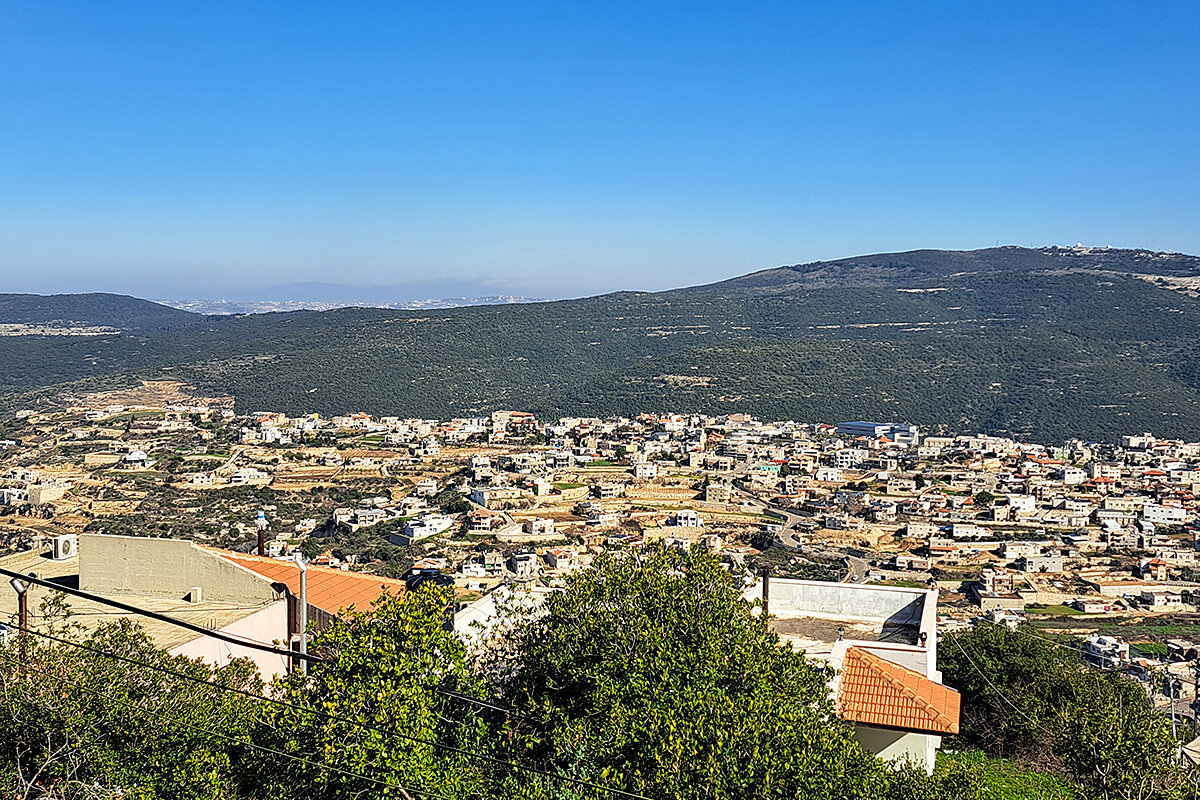
With the hillside geography intertwined with their Druze identity, Beit Jann’s residents refuse to leave their ancestral land, even as Israel evacuates nearby kibbutzim and the Israel-Hezbollah exchanges intensify.
Instead, they want people to come.
“We want everyone to come here, try our hospitality, and experience the peacefulness among these mountains,” resident Suzan says as she takes her toddler to school. (She declined to offer her last name.)
Located in the heart of a nature reserve that had been witnessing a tourism revival, Beit Jann normally sees thousands of weekend visitors: bird-watchers, backpackers, and couples looking for a romantic getaway in one of its dozens of guesthouses.
This weekend, no visitors were to be seen.
The village’s Peace Park, a collection of olive trees and a playground built by residents to commemorate the United Arab Emirates-Israel Abraham Accords normalization agreement, was empty.
Yellow ribbons and silver bells – tied to tree branches in solidarity with Israelis held hostage by Hamas in Gaza – fluttered and clinked in the wind.
Residents hope the war ends and tensions ease by spring, when the village holds its annual festival welcoming the short bloom of the wild peony, a vibrant violet flower rare in the Middle East and only found in Israel on one mountain at the edge of the village.
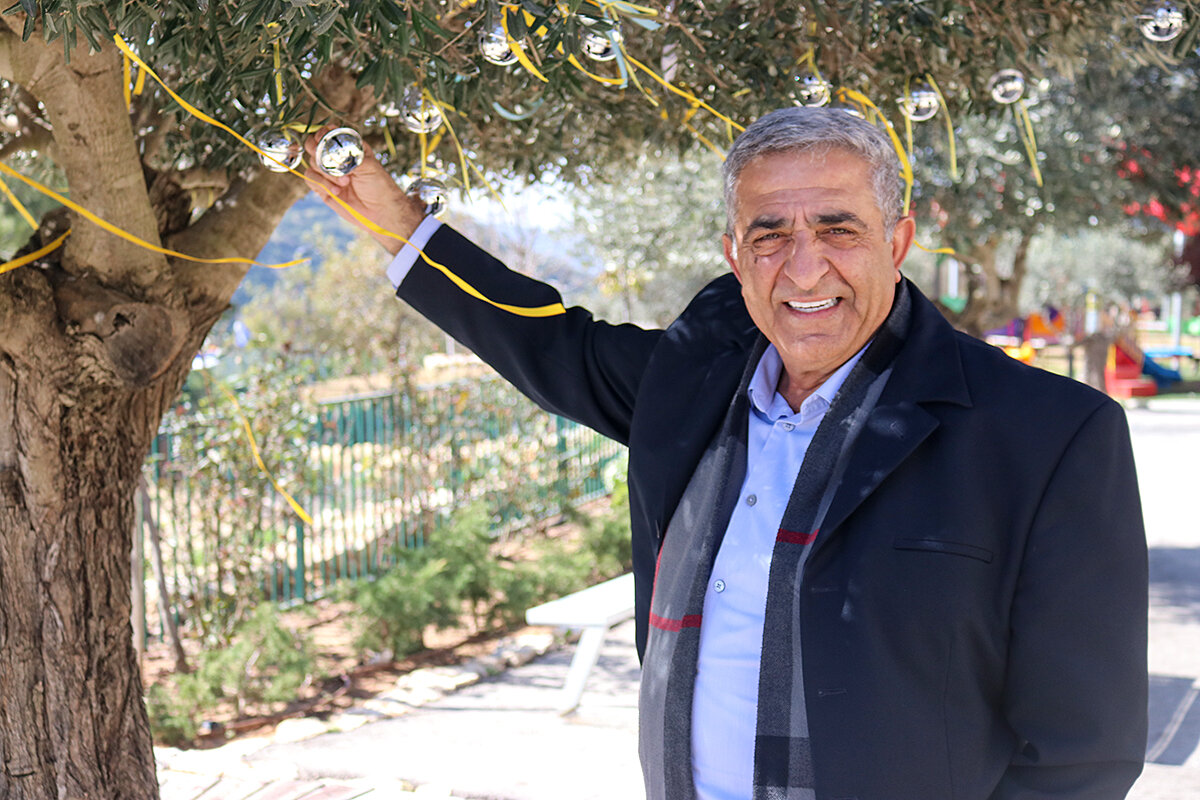
Standing atop a hill, moving his arm just a few degrees, Mr. Najm points out Syria, Jordan, and Lebanon, all visible, but separated from Beit Jann by enmity, borders, and politics.
A century ago, these lands were connected. Today, they might as well be on different continents.
“We would love it if the Jordanians, Syrians, and Lebanese would all come to Beit Jann,” says the mayor, repeating with emphasis, “love.”
“We want everyone to come here, share our message of peace, visit this beautiful place, and see coexistence among peoples is possible. We can disagree with one another, but we can still show empathy, understanding, and respect.”
Mr. Najm drives up to another, steeper summit and checks on the work on a new park atop the highest peak in the village and one of the highest in all of Israel, overlooking the nearby Lebanese villages of Yaroun and Rmaich.
He urges the contractor to “get a move on.” He is anxious to have the park done by the end of January, ahead of the hoped-for spring visitors season.
The park, to be fitted with an observatory tower, gives visitors a 360-degree view of Israel, the Mediterranean, northern Jordan, the Golan Heights, and Lebanon.
“When we’re done, you’ll be able to see Nasrallah from here,” the contractor says of Hezbollah leader Hassan Nasrallah, without a hint of hyperbole or sarcasm.
Even as dozens of Beit Jann’s sons fight Hamas in Israel’s war in Gaza, Hezbollah and its patron Iran are on everyone’s minds.
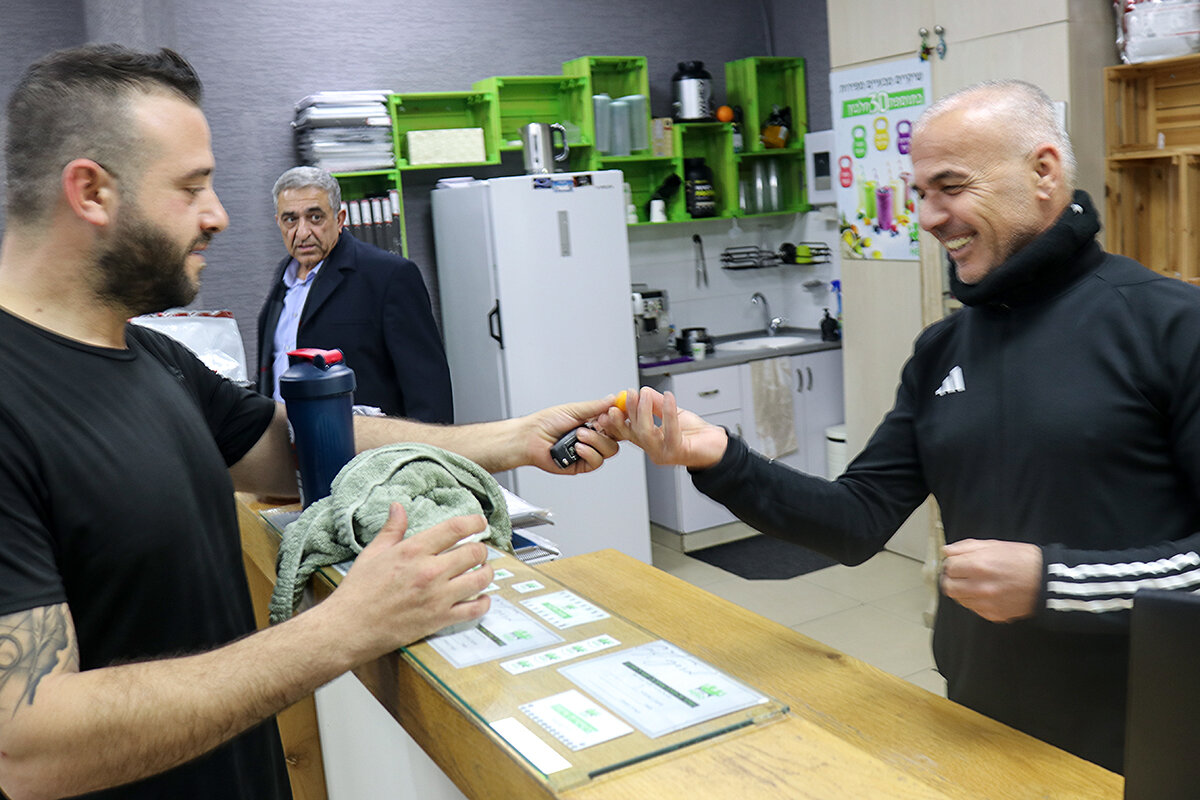
“There can be no peace if Hezbollah is there,” Eyhab, a police officer who offered only his first name, says as he wraps up a morning workout at the local gym.
“Hezbollah and Iran don’t want peace, even though the peoples in the region do. If we can get rid of Hezbollah and Iranian influence, there will be peace.” Eyhab flexes his bicep. “They think they can scare us, but we Druze are strong.”
Unlike many Israeli communities, Beit Jann has no public shelters, and many of the homes, built into mountain rock, some generations old, lack safe rooms for residents to run to.
When sirens blare, if residents cannot reach a safe room or the village school, they simply duck and cover in place.
Since two rockets landed outside the village Jan. 7, residents can no longer reach their vineyards and apple orchards closer to the border, threatening this year’s harvest of Beit Jann’s famous fruits.
“Everyone loses in war and no one gains,” Mr. Najm says. “The only question is how much suffering must there be until everyone realizes there is no alternative to peace.”

Unpacking the debate over migrant work permits
There’s a growing push from mayors and immigration advocates to urge federal action on expanding work permits for migrants. Whether that helps or hurts the U.S. is a matter of dispute.

- Quick Read
- Deep Read ( 4 Min. )
As incoming migrants to the United States fill shelters and streets from coast to coast, immigrant advocates and liberal politicians are calling for expanded access to work permits. Conservative critics say such moves could further enable already record levels of migration at and between official points of entry at the southern border.
Whether noncitizens are eligible for a work permit in the U.S. depends on their immigration status. Asylum-seekers, for instance, must wait at least six months before obtaining permission to work. Noncitizens eligible for temporary protected status or paroled into the country have a path to apply for work authorization. (Both are a type of temporary, time-limited permission to remain legally in the U.S.)
The president’s use of immigration parole – an authority created in the 1950s – has become increasingly controversial. It’s the subject of federal litigation by several Republican-led states and a thorn in congressional budget debates.
How observers value access to work authorization can reflect their stance on who should be allowed to enter. Advocates often focus on the right to seek asylum under U.S. law, while conservatives argue that current operations let in too many people unlikely to merit protection.
Unpacking the debate over migrant work permits
As incoming migrants to the United States fill shelters and streets coast to coast, immigrant advocates and liberal politicians are calling for expanded access to work permits. Conservative critics say such moves could further enable already record levels of migration at the southern border.
Meanwhile, to support themselves and their families, some migrants are finding informal work, exposing themselves to underground-economy risks like wage theft. Many are in immigration court proceedings, which may take years in a system backlogged by 3 million cases.
The procedural and practical barriers to work permits depend on each person’s case.
Why are so many migrants left without work permits?
Like most immigration matters, it depends.
Whether noncitizens are eligible for a work permit in the U.S. can depend on their immigration status. How long ago they applied for asylum can factor in, too. And sometimes, for special immigration programs, their nationality and date of arrival matter.
Migrants who have a path for work authorization include those who are eligible for temporary protected status or were paroled into the country. (Both are a type of temporary, time-limited permission to remain legally in the U.S.) In recent years, the Biden administration has expanded parole opportunities for some individuals from Cuba, Haiti, Nicaragua, Ukraine, and Venezuela.
The president’s use of immigration parole – an authority created in the 1950s – has become increasingly controversial. It’s the subject of federal litigation by several Republican-led states and a thorn in congressional budget debates.
Another route to work permits is applying for asylum based on fear of persecution back home. After submitting an asylum application, a migrant must wait at least 180 days to obtain a work permit. That delay comes from a law passed on Capitol Hill 28 years ago.
What’s the role of Congress?
Congress makes immigration law. In 1996, it codified into law a six-month mandatory wait after an asylum claim is filed before individuals could obtain a work permit. The view from 2024, however, is that the wait didn’t curb demand to come.
Now, several state and city officials are calling on the federal government for help as they manage increased numbers of migrants relying on local government services. That includes Denver Mayor Mike Johnston, whose city has tracked the arrival of around 38,000 migrants since late 2022.
“All that is required is a clear act of courage from the Congress to take action on the things that cities need to be successful,” Mayor Johnston told reporters on Thursday in Washington. Along with work authorization, he said, cities like his need more federal aid and coordination of incoming arrivals.
In early 2023, House Democrats and Senate Republicans introduced bills to narrow the wait period for asylum-seekers’ work permits to 30 days. Beyond pleas to Congress, local officials have also appealed to President Joe Biden for support. His administration took limited action in September by offering temporary protected status for Venezuelans who entered the country by July 31, 2023.
The government has also sped up work-permit processing, particularly for certain parole-based cases, and continues public awareness efforts to reach eligible migrants who have yet to apply, says U.S. Citizenship and Immigration Services in an email. Yet beyond the timeline of approval, the cost of some work-permit applications and navigating filing and fee waivers are other practical barriers – ones that clinics nationwide have tried to ease.
Why is the issue of migrant work permits controversial?
How observers value access to work authorization can reflect their stance on who should be allowed to enter. Advocates often focus on the right to seek asylum under U.S. law, while conservatives argue that current operations let in too many people unlikely to merit protection.
Allowing more migrants to work could help with labor shortages, says Jennie Murray, president and CEO of the National Immigration Forum. “Not allowing someone to work is basically, by default, forcing them to be dependent on charity,” she says.
Critics, on the other hand, say that easier access to work permits could encourage the arrival of more economic migrants who may be ineligible for protections like asylum. That relief is granted at the government’s discretion.
“If you are telling economic migrants, ‘Come to the border, say “I want asylum,” and we’ll hand you a work permit’ ... that’s only going to create more incentives for people to abuse the system,” says Ira Mehlman, media director at the Federation for American Immigration Reform.
Immigration experts say that beyond the “pull” factors of migration, there are “push” factors, including other countries’ political and economic crises beyond U.S. control.
Are there consequences for working without a federal work permit?
Again, it depends.
“It’s really complex,” says Amy Grenier, policy and practice counsel at the American Immigration Lawyers Association. “Working without authorization can have implications on someone’s immigration process,” she says. However, “it depends a lot on the case.”
With unauthorized work, the liability is more so on the employer, says Jennifer Lee, associate professor of law at Temple University in Philadelphia. Under federal immigration law, it’s illegal for employers to knowingly hire noncitizens without work permits. The worker can face consequences if they provide false documents.
The absence of work authorization “makes it incredibly hard for folks to find work,” says Professor Lee, “because most employers don’t want to violate federal law and hire somebody without work authorization.” Workplaces that do assume the legal risk of hiring these individuals could exploit them.
Labor law adds another layer of complexity. Experts say that if a migrant does work without a permit, workers’ rights laws at the state and federal levels – like protections against wage theft – still apply to them. The Department of Homeland Security has signaled it may consider immigration protections for unauthorized migrants, on a case-by-case basis, for those who choose to speak up.

At Sahara’s edge, old habits protect crops from new climate
As policymakers and governments worldwide scour for ways to cope with the climate emergency, a small town in Senegal shows that solutions can come from those closest to the effects.
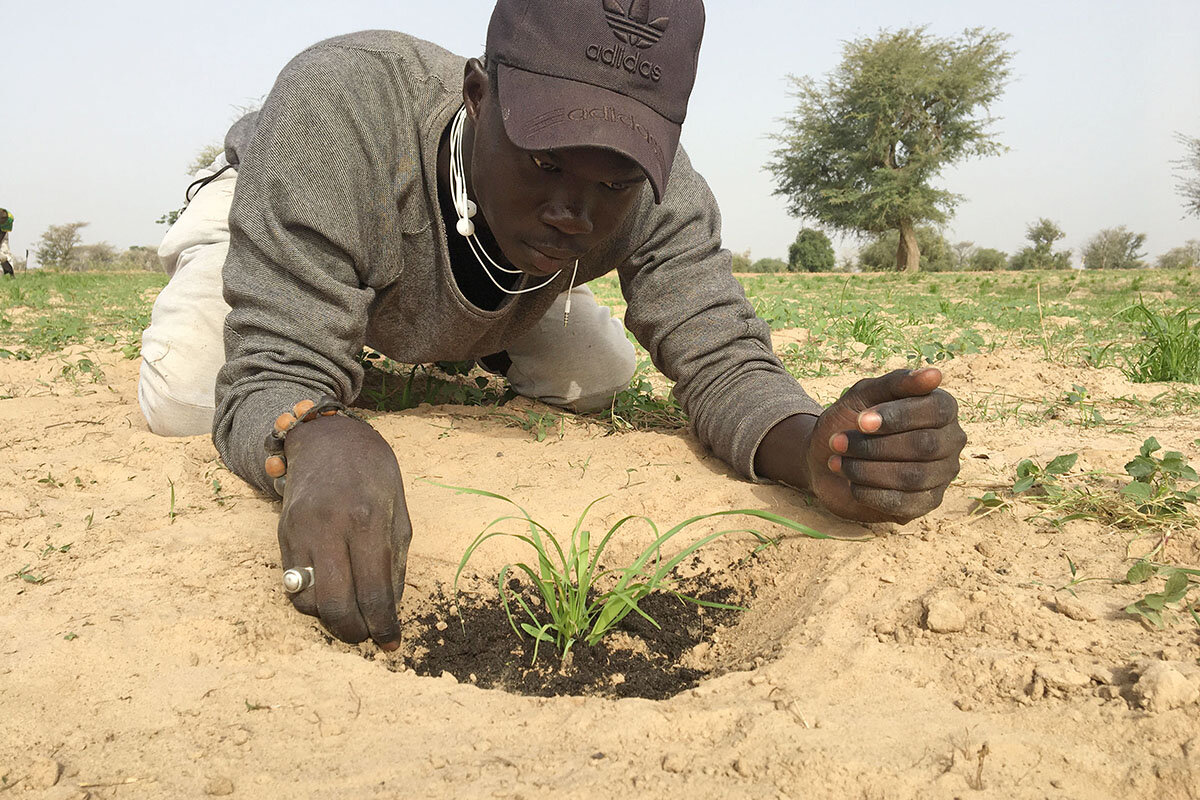
- Quick Read
- Deep Read ( 4 Min. )
-
By Jack Thompson Contributor
Rain is like alchemy for farmer Thialla Badiane. Briefly, it transforms dusty dunes into rich verdure, barren plains into crop-laden fields.
Here on the frontier of the Sahara desert, temperatures are rising by 50% more than the global average, rainfall is becoming more unpredictable, and droughts last longer.
In response, hundreds of farmers in Mr. Badiane’s town of Ndiob have revived the ancient technique of zaï, which involves making small indentations in the ground that capture rainfall and increase the fertility of the soil.
Farmers are experimenting with earth auger drills to make the process more efficient. In one hectare, Mr. Badiane will drill 10,000 holes for his millet seeds.
Research shows zaï can triple production, reducing Senegal’s heavy reliance on food imports. “It could ... save the state a lot on the balance of payments,” says economist Alasanne Seck.
The United Nations hailed 2023 as the “year of millet” because the crop can grow on arid land, can survive extreme heat, and is high in protein and micronutrients. So it’s an ideal way for countries to improve their self-sufficiency.
When Mr. Badiane admires his ready-to-be-harvested plants months later, they tower over him. It promises, he says, to be a good harvest.
At Sahara’s edge, old habits protect crops from new climate
Rain is like alchemy for farmer Thialla Badiane in the Sahel region of Senegal. Suddenly, it transforms dusty dunes into rich verdure, barren plains into crop-laden fields.
But rain is increasingly scarce here on the edge of the Sahara desert. Temperatures are rising by 50% more than the global average and threatening Mr. Badiane’s most precious resource to feed himself and his seven children.
Annual rainfall could drop by 38% in Senegal in the coming decades, a threat to the way of life for the nation’s 8 million farmers. Already the growing climate emergency means rainfall has become more unpredictable, water scarcer, and droughts longer.
So in Mr. Badiane’s hometown of Ndiob, hundreds of farmers seeking to combat those effects have revived an ancient farming technique – with a 21st-century twist.
A blaring engine resounds across the arid landscape of Mr. Badiane’s plot, punctuated only by hardy acacia trees and thick-trunked baobab trees, as he drills repeatedly into the thick crust of the earth with a giant motor-powered corkscrew, leaving a pattern of perfectly spaced holes. In one hectare, he will drill 10,000 holes for his millet seeds, a planting technique known as zaï.
Originally from neighboring Burkina Faso, zaï is the traditional technique of making small indentations in the ground that capture rainfall and increase the fertility of the soil. It’s painstaking work, but a lot easier than digging the holes by hand with a hoe.
“When we did it manually, I couldn’t bear to come back in the afternoon,” bellows Mr. Badiane over the roar of the engine. “It would take days.”
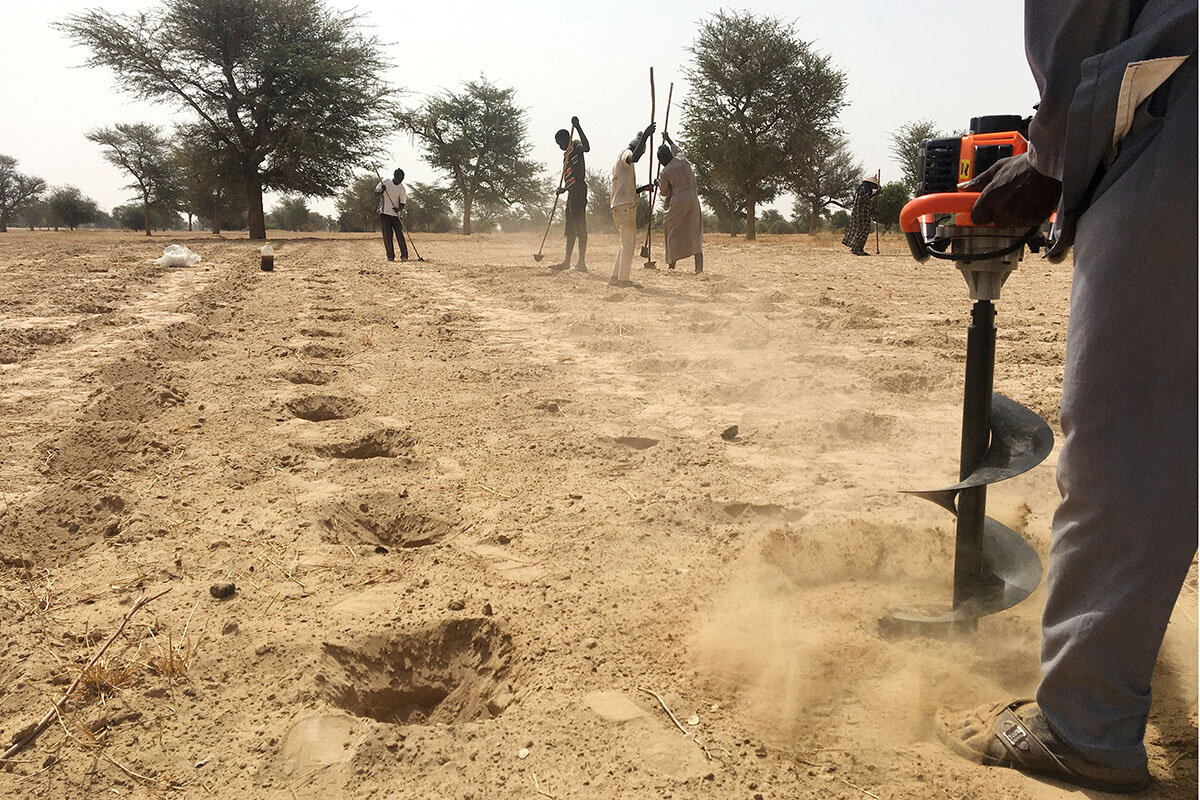
Indigenous inspiration
Millet has been making waves on the international stage. The United Nations hailed 2023 as the “year of millet” because the crop can grow on arid land, can survive extreme heat, and is high in protein and micronutrients.
And with his modern take on an ancient practice, Mr. Badiane has increased his yield of millet by 50% – though research shows zaï can triple production. If it were to become widespread, this Indigenous technique could help farmers become more resilient to a changing climate, growing food without chemicals and reducing Senegal’s heavy reliance on food imports.
This is the ambition of Ndiob’s Mayor Oumar Ba, renowned in Senegal for his commitment to agroecology, a form of sustainable farming based on millennia of Indigenous knowledge and innovation.
Until now, zaï has taken too much time to be popular. But 500 farmers in Ndiob, supported by Mr. Ba, are re-imagining the ancient practice, experimenting with earth auger drills to make it more efficient and appealing to farmers.
Africa is the continent that will feel the effects of climate change most strongly. And its people have the least support to adapt to its knock-on effects – including drought, hunger, displacement, and conflict.
Across the continent, many officials, scientists, and ordinary citizens are already looking to adapt. Faced with increasingly unpredictable weather in Ndiob, Mr. Ba traveled to Burkina Faso, a landlocked nation that gets even less rain than Senegal, to search for ways to beat intensifying drought. Four years ago, he brought back zaï.

“Before, it used to rain consistently for five months; it would start in June and end in November,” says the mayor’s agricultural advisor, Mame Kor Faye. “Now, not one farmer can tell you when the season will start. This is very worrying for farmers who have been used to farming the same way for generations.”
Drought is a vicious circle for farmers: As rainfall decreases, the soil compresses. When it finally does rain, the dehydrated, packed land cannot absorb the water and the top layer of fertile topsoil washes away. Zaï combats this by creating pockets for the water, making sure it doesn’t run off and take nutrients and minerals with it.
“Zaï is a solution to this scarcity of water and to restore the fertility of our soils,” Mr. Faye says.
A double win
For Mr. Badiane, the planting plots are a double win.
Under the burning November sun, he bends over each small pit and delicately places a handful of rich, dark fertilizer. It’s a far smaller amount than he used when he composted his entire field.
Prices of fertilizer have skyrocketed since Russia, the world's top exporter, invaded Ukraine and supplies were squeezed. Since then, animal manure, an alternative to chemical fertilizer, has been in short supply.
“The reason zaï interested me is because I wanted to save on organic manure,” Mr. Badiane says. “Before, you didn’t have to pay for manure – livestock herders would give it to you. Now it’s hard to find, and you have to pay.”
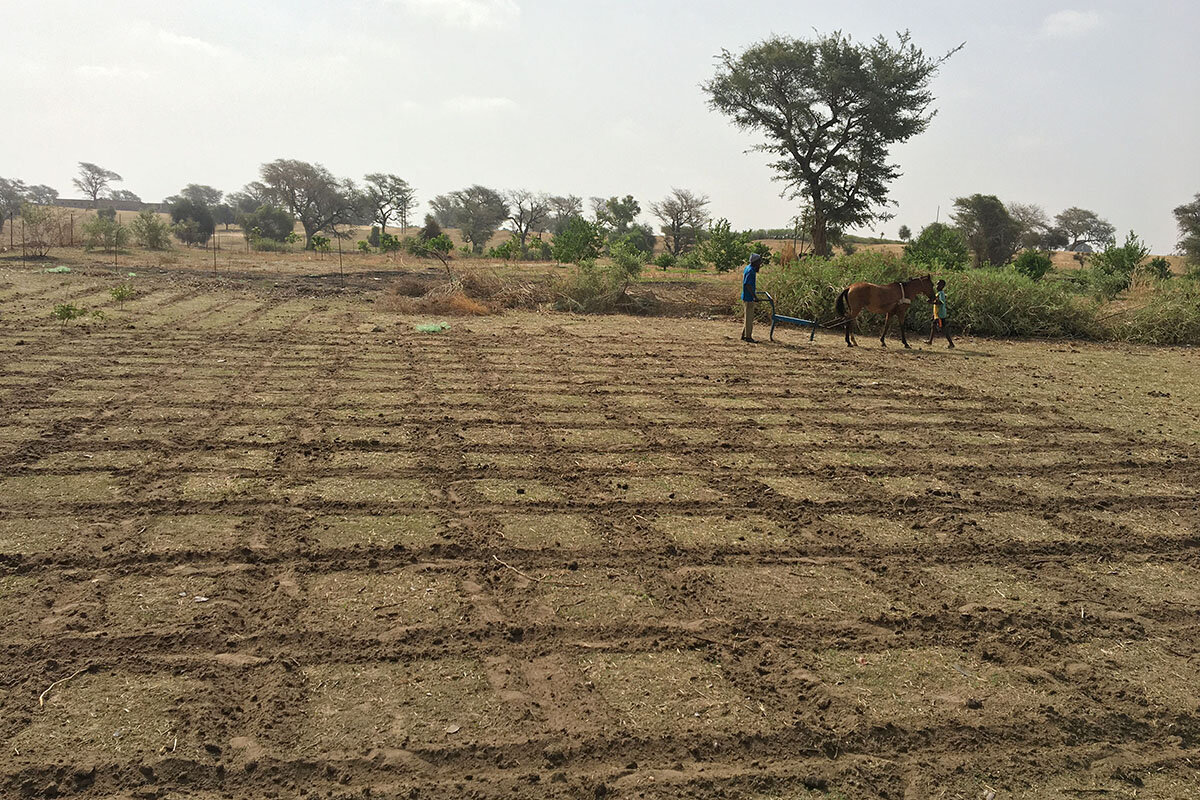
“When the rain falls on the manure, it retains the humidity that the plant needs,” says Isidore Diouff, an agronomist from the Senegalese nongovernmental organization Enda Pronat and who has been leading the zaï experiments in Ndiob. He kneels down to inspect a newly planted seed in its pit. “You can go 20 days without rain, and the pit will still be damp.”
Four months later, Mr. Badiane admires his ready-to-be-harvested, fingerlike plants. Nurtured by the moist soil, their soaring leaves tower over the 6-foot-tall farmer. Assessing the plant’s density and weight, Mr. Badiane predicts a good yield.
Despite increasing his millet harvest, Mr. Badiane is not done improving yet. His drill, for example, is better than a hand hoe, but it is still not well adapted to soil as dry as his field has become. And he hopes to see more fruit from his labor.
“I farm to send my seven children to school, to feed them, to heal them when they’re sick,” he says. “One day, I want to be able to buy my son a bike.”

Essay
Let there be light: Re-sparking my love of learning
Placing oneself in uncomfortable situations runs counter to our wiring. But, as our writer learned, in pushing past our self-made boundaries lies discovery, growth, and new horizons.
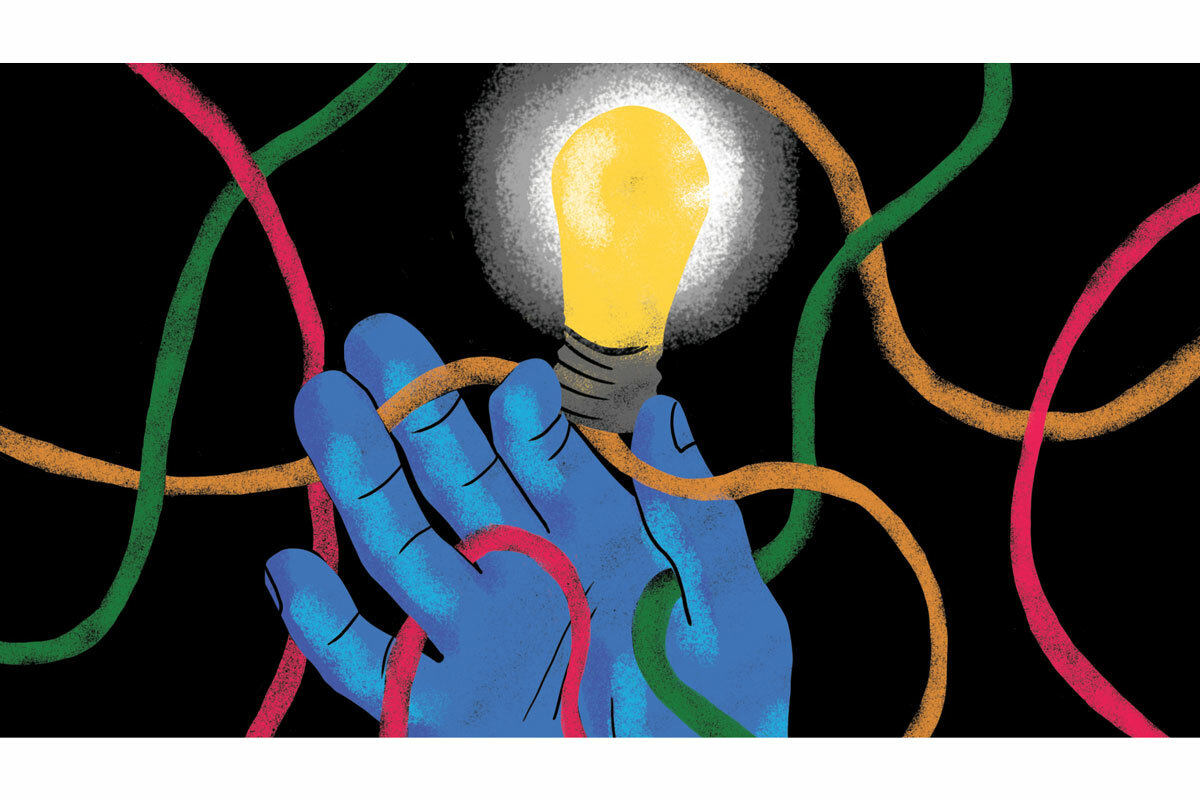
- Quick Read
- Deep Read ( 3 Min. )
-
By Robert Klose Contributor
There I was, a Ph.D. in biology, a veteran professor, an esteemed lecturer, standing like a fresh-faced schoolboy in an adult evening course at a local technical school: Basic Electricity and Wiring.
I felt immediately overwhelmed. So much new terminology, not to mention protocols and safety codes. In an instant, I was a student again in all respects: the anxiety, the self-doubt, the wondering if I had made a mistake.
And then I recalled something President Calvin Coolidge had said about stick-to-itiveness: “Nothing in the world can take the place of persistence.”
Step by step, sometimes achingly, I was learning about voltage, amperage, ground wiring, and various types of electrical fittings. Of course, none of this would have been possible had I not committed myself, sometimes amid tremendous misgivings, to stick with it.
I felt that something bigger than myself was at stake – an affirmation that learning is not something that is wrapped up early in life, from which point we simply sail forth, constantly recycling what we already know. The horizon is broader than that, and the broader the horizon, the more opportunities there are to learn something new.
Let there be light: Re-sparking my love of learning
As a university professor, I have been marinating in theory and conjecture for so long that it recently struck me: I don’t know how to do anything.
By “do,” I mean something material, something done with my hands that produces an actual product.
The trades come to mind. Whenever I call an electrician, or a mason, or a carpenter, I look on in wonder as they fluidly employ their skills. I recently had a new kitchen sink installed by a young man who had dropped out of his college engineering program to take up plumbing. He hummed as he worked at the pipes, with enviable confidence in his abilities. When he was done, the moment of truth: He turned on the water and it flowed forth with nothing resembling a leak. Is this not a minor miracle?
But it is the electrician who, for me, elicits the most wonder. I mean, plumbing is one thing, because you can see water. But electricity is the flow of invisible electrons. I recently had need of an electrician and looked on as she twisted and untwisted and cut and joined masses of wires, which she wove between her fingers like intricately tangled noodles. Again, when she was done, the acid test: a flip of the switch and – voilà! – light.
All of this brought me to a cataclysmic decision: I would go on hiatus from my theories and hypotheses and learn –
actually learn – something about the practical aspects of electricity.
And so, I registered for an adult evening course at a local technical school. The title: Basic Electricity and Wiring.
Perfect.
When we began, I felt immediately overwhelmed. So much new terminology, not to mention protocols and safety codes. In an instant, I was a student again in all respects: the anxiety, the self-doubt, the wondering if I had made a mistake. Was it possible that I didn’t have what it took to understand this field of study?
And then I recalled something President Calvin Coolidge had said about stick-to-itiveness: “Nothing in the world can take the place of persistence. ... Education will not; the world is full of educated derelicts.”
Was this what I was then? An educated derelict? After 30-plus years of university teaching? This thought nagged at me as I worked my way through my basic wiring course. My initial impulse to jump ship gradually gave way to the realization that I was, indeed, acquiring a useful new skill.
Step by step, sometimes achingly, I was learning about voltage, amperage, ground wiring, and various types of electrical fittings. Of course, none of this would have been possible had I not committed myself, sometimes amid tremendous misgivings, to stick with it. (This is as important as it sounds – a third of the class dropped out along the way.)
What loomed ahead was the course’s capstone: Each student would be presented with a switch and a lighting fixture. The task was to install them in a door frame and wire them, but not throw the switch until the instructor was present.
There I was, a Ph.D. in biology, a veteran professor, an esteemed lecturer, standing like a fresh-faced schoolboy before my setup. And so I worked away, wielding my tools, trying to remember where the hot, neutral, and ground wires connected.
When I was done, I raised my hand. The instructor, a master electrician, swaggered over, his expression betraying no hint of what he expected to see. He looked over my job, hummed disconsolately, and glanced at me. “Hit the switch,” he said.
It’s hard to characterize that moment. It would be an exaggeration to say that I felt that the fate of the planet depended on my success. But I did feel that something bigger than myself was at stake – an affirmation that learning is not something that is wrapped up early in life, from which point we simply sail forth, constantly recycling what we already know. The horizon is broader than that, and the broader the horizon, the more opportunities there are to learn something new.
I hit the switch.
There was light.
In more ways than one.
Other headline stories we’re watching
(Get live updates throughout the day.)The Monitor's View
Useful reckonings in Mideast conflicts
- Quick Read
- Deep Read ( 3 Min. )
An intensifying exchange of artillery fire across Israel’s northern border with Lebanon has elevated concerns that the crisis in Gaza is spreading into a regional conflict. Within those two countries, however, two unusually candid volleys in recent days hint at something else. Amid war, Arabs and Israelis may be sowing seeds of stability through new commitments to democracy.
An exchange of words between leaders within Israel and Lebanon, respectively, reflects how, in times of war, negatives can sometimes galvanize positives. As the Global Security and International Affairs program at the American Academy of Arts & Sciences recently noted, a breakdown of civilians’ trust in institutions and politicians during conflict “in certain cases ... may indicate that democracy is functioning.”
New polls provide a granular view of the Israel-Hamas war’s impact on Arab public thought. Several metrics show increased solidarity with Palestinians since the start of the war. But two findings, published this week by Arab Barometer, show that while support for Hamas has tripled in the West Bank since October, it has barely moved in Gaza. Both measure discontent over governance – with Hamas in Gaza, where it has governed; and with the Palestinian Authority in the West Bank, where it governs.
Useful reckonings in Mideast conflicts

An intensifying exchange of artillery fire across Israel’s northern border with Lebanon has elevated concerns that the crisis in Gaza is spreading into a regional conflict. Within those two countries, however, two unusually candid volleys in recent days hint at something else. Amid war, Arabs and Israelis may be sowing seeds of stability through new commitments to democracy.
Hassan Nasrallah, the leader of the Iran-backed Hezbollah in southern Lebanon, declared earlier this month that the war in Gaza has opened “a historic opportunity to completely liberate every inch of our Lebanese land.” In a sermon the following day, Bechara Boutros Al-Rahi, patriarch of Lebanon’s Christian Maronite sect, responded that “we must ... spare Lebanon and the Lebanese, through wisdom and self-restraint, from entering [the] war.” He added, “The decision on war and peace rests exclusively with the government ... in line with the Constitution.”
A similar exchange occurred last night in Israel. In a press conference, Prime Minister Benjamin Netanyahu vowed to “continue the fight with full force” in Gaza until Israel had achieved “total victory over Hamas,” the militant Palestinian group that had governed the enclave and attacked Israel last October. That pledge met a rare open rebuke from former military chief Gadi Eisenkot, an observer to the country’s war Cabinet. “It is necessary,” he said in a TV interview, “to return the Israeli voter to the polls and hold elections in order to renew trust because right now there is no trust.”
Such affirmations of democratic principles reflect how, in times of war, negatives can sometimes galvanize positives. As the Global Security and International Affairs program at the American Academy of Arts & Sciences recently noted, a breakdown of civilians’ trust in institutions and politicians during conflict “in certain cases ... may indicate that democracy is functioning.”
Two new polls provide a granular view of the Israel-Hamas war’s impact on Arab public thought. Several metrics show increased solidarity with Palestinians since the start of the war. But two findings, published this week by Arab Barometer, are particularly revealing. One shows that while support for Hamas has tripled in the West Bank since October, it has barely moved in Gaza. Both measure discontent over corruption and governance – with Hamas in Gaza, where it has governed; and with the Palestinian Authority in the West Bank, where it governs.
The survey confirmed that disenchantment in a second way: 51% of Palestinians would refuse to vote in an election contested by the current leadership of either faction.
“What Arab publics want most from democracy is not elections but other integral elements: less corruption, better services, more effective governance, greater individual freedoms, and economic opportunity,” according to the Washington Institute for Near East Policy.
That may be what compelled Abdallah Bou Habib, Lebanon’s caretaker foreign affairs and emigrants minister, to affirm last month that his government remains committed to “diversity, pluralism, and peaceful coexistence.”
It may also be the most important factor motivating Arab leaders to seek a diplomatic formula for ending the conflict in Gaza. Since the start of the war, public opposition to normalizing ties with Israel has risen by as much as 30% in countries that have already taken that step or were moving in that direction, according to a survey published last week by the Arab Center for Research and Policy Studies in Doha, Qatar. Arab citizens are pointing their discontent toward their own governments as much as at Israel.

A Christian Science Perspective
Each weekday, the Monitor includes one clearly labeled religious article offering spiritual insight on contemporary issues, including the news. The publication – in its various forms – is produced for anyone who cares about the progress of the human endeavor around the world and seeks news reported with compassion, intelligence, and an essentially constructive lens. For many, that caring has religious roots. For many, it does not. The Monitor has always embraced both audiences. The Monitor is owned by a church – The First Church of Christ, Scientist, in Boston – whose founder was concerned with both the state of the world and the quality of available news.
Make my life a prayer
- Quick Read
- Read or Listen ( 4 Min. )
-
By Bobby Lewis
When conflicts feel big and far away, putting our prayers into practice in our own lives gives them wings.
Make my life a prayer
I once heard someone answer the question, “What would you do differently if you had the chance?” with “I would make my life a prayer.”
When I am praying about difficult situations in the world, part of what I am attentive to is to really work to follow that model and make my life a prayer. In other words, I seek to put into practice in my own day-to-day experiences what I am praying about for others, and to be open to fresh, God-inspired solutions that change the storyline.
With the wars in the Middle East and Ukraine, and the many other conflicts happening right now, I have been praying about the God-given ability for people in all the various factions to move beyond entrenched positions to openness to new solutions and approaches. This prayer rests on the trust that God, good, who is the all-knowing Mind, continuously communicates pertinent spiritual ideas that bring to light inspiration and potential solutions which respond to and meet everyone’s specific needs.
My prayer is that the people involved are able to hear and respond to ideas from the divine Mind which lead toward civility, provision, resolution, and peace. As sons and daughters of God, we are created to be responsive to divine direction. We have an inherent perceptiveness of inspiration, because we are the spiritual expressions of Mind, which is the source of answers that result in genuine progress.
A unique aspect of prayer in Christian Science is the impetus to start with the solution by asking the Divine to reveal what it already knows to be true about all that are involved in a situation, rather than starting with the problem and trying to work out how to somehow get to a place of progress. This solution-oriented approach comes from Scripture, as when the prophet Isaiah recorded God saying, “I am God, and there is none like me, declaring the end from the beginning” (Isaiah 46:9, 10).
In other words, divine Mind knows, and shows right up front, the truth about its absolute presence, power, and goodness. As Mary Baker Eddy, the founder of Christian Science, wrote, “The finite must yield to the infinite,” and that can happen in a moment (“Science and Health with Key to the Scriptures,” p. 256).
I recently experienced how putting my prayers for others into action in my own life gives a particular power and legitimacy to those prayers. When I pulled up to a parking lot for a trailhead on public land where I was planning to go for a hike with a friend, I saw that a large group had commandeered the parking lot and turned it into a camp. As I parked, they approached my truck, yelling at me to leave. They made it clear that they didn’t want anyone else in the lot, and that if I parked and left my truck, they would damage it. Things were not heading in a good direction, so I paused and prayed.
I asked God for guidance as to how to see these men as God already did and how to respond as a son of God and not from a standpoint of frustration. I had no doubt that the true, Spirit-created nature of the men involved had to be reflective of the goodness and peace of their source, God. What came in inspiration was that God knew these people as blessed – not based on their actions, but rather, based on knowing their real God-created spiritual identity.
Then I said out the window to the group, “God bless you.” This was not with sarcasm; I really felt it. All the tension left. Each person went back to what they were doing. There were no further problems. Although it was clear to me that I could have safely remained in the parking spot I was in, I felt that same Christly spirit that had diffused the situation gently nudging me to park at another spot nearby – convinced that anyone else pulling into the lot would receive a courteous welcome.
It felt like God’s presence was shining for us to see. And my receptivity to that presence came from humble, listening prayer and being willing to see a storyline that expressed God’s design, instead of the tension and conflict that had momentarily seemed to be in the driver’s seat.
That evening, as I was praying about the current conflict in the Middle East, I knew that people there could be experiencing in significant ways the sort of peaceful resolution that I had just experienced.
When we individually pause, pray for those in need, and then seek to make our own lives a prayer that reflects our hopes for others, we can trust that those lived prayers are making a difference collectively. They help reveal fresh God-inspired solutions that lead to more harmonious storylines in places of conflict around the globe.

Viewfinder
Power play
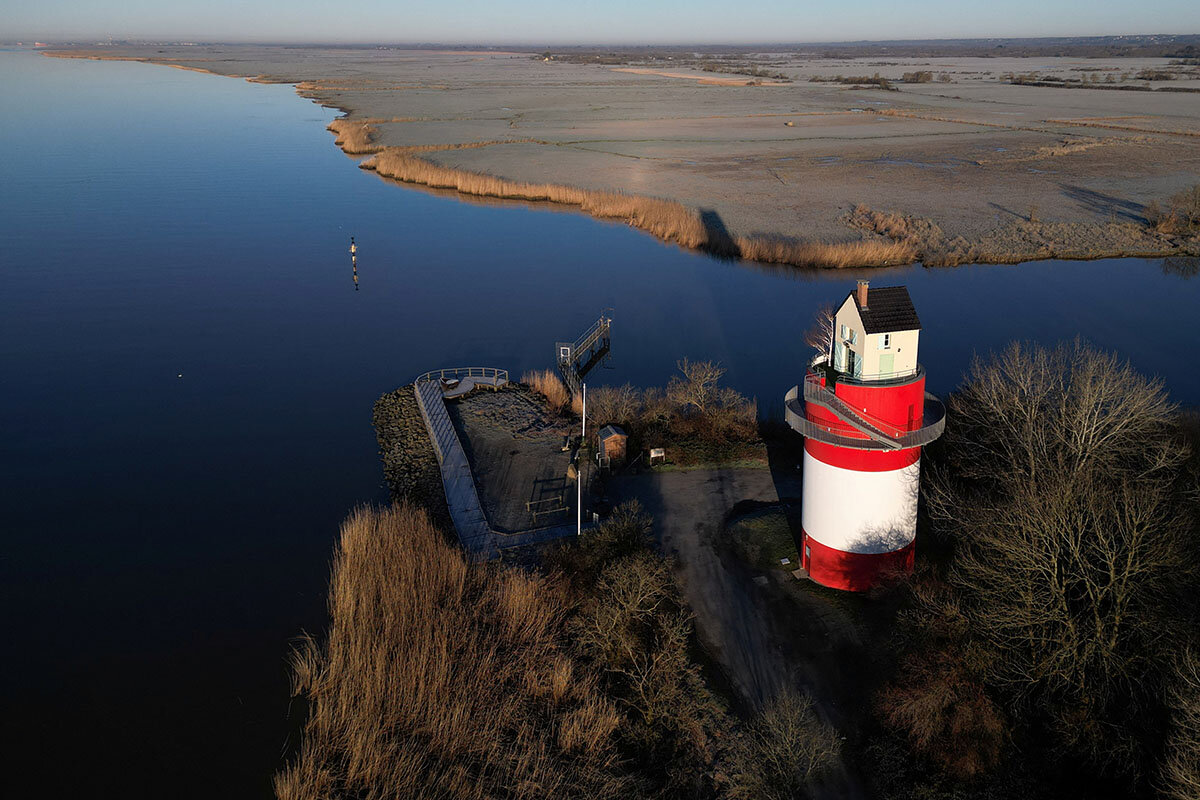
A look ahead
Thank you for joining us this week. We’ll be back Monday with more on preparations for the New Hampshire presidential primary, as well as developments in the Middle East.
For those of you who read our weekly political roundup last Friday and sent in feedback, thank you! We will not have a roundup this week, as we are taking all your comments into consideration. We’ll keep in touch about our next steps.


